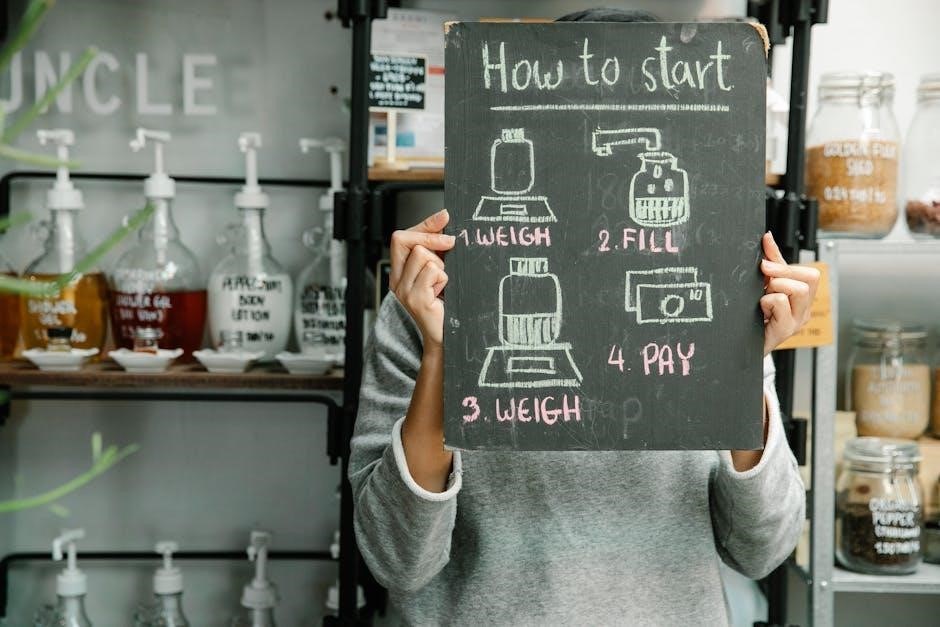Nood Instruction Manual Article Plan
This article provides a comprehensive guide to using the Nood IPL hair removal device. It covers preparation, usage, treatment schedules, safety, troubleshooting, and device maintenance, ensuring effective and safe hair removal at home.
The Nood Flasher 2.0 IPL Laser Hair Removal Device offers a convenient way to achieve semi-permanent hair reduction at home. Utilizing Intense Pulsed Light (IPL) technology, the device targets hair follicles to inhibit future growth. Nood aims to simplify hair removal, providing an accessible solution with the Flasher 2.0. It is designed for both men and women. The device is intended for safe and effective use on the whole body.
Nood requires completing a skin safety test before treatment, ensuring compatibility and minimizing risks. With a 90-day guarantee, Nood allows users to try the device risk-free, offering refunds if desired results are not achieved. The user manual provides straightforward instructions, making the process easy.

Preparing for Nood Treatment
Before using the Nood device, cleanse the treatment area thoroughly. Shave and exfoliate the skin to ensure optimal results. These steps help the IPL reach the hair follicle effectively.
Cleansing the Treatment Area
Prior to using the Nood device, ensure the skin is freshly cleansed. IPL hair removal is most effective on clean skin, as dirt, oil, and residue can hinder the laser’s ability to target hair follicles effectively. Use a gentle cleanser to remove any impurities from the area you plan to treat. This ensures that the light energy from the Nood device can be properly absorbed by the hair follicle. Cleansing prepares the skin for optimal treatment and helps prevent potential skin irritations. A clean surface allows for better contact between the device and the skin, improving overall results.
Shaving and Exfoliating
Before using the Nood device, proper skin preparation through shaving and exfoliating is crucial. Shave the treatment area to remove hair from the skin’s surface, allowing the IPL energy to target the hair follicle beneath the skin effectively. Exfoliating removes dead skin cells, providing a smoother surface for the Nood device to glide over and ensuring better light absorption. This process minimizes the risk of surface-level skin irritation and maximizes the penetration of the IPL energy. Both steps contribute to a more effective and safer hair removal experience, enhancing the overall results of each Nood treatment session.

Using the Nood Device
This section explains how to safely and effectively use the Nood device. It covers conducting a skin safety test, selecting the appropriate intensity level, and properly flashing the device for hair removal.
Skin Safety Test
Before commencing full treatment with the Nood device, performing a skin safety test is crucial. This test helps determine the appropriate intensity level for your skin and identifies any potential adverse reactions. Select a small, inconspicuous area of skin, such as the inner arm. Turn on the device and start with the lowest intensity setting. Flash the device on the test area and wait for 24-48 hours.
Check the area for any signs of redness, itching, or irritation. If no adverse reactions occur, proceed with the treatment, gradually increasing the intensity level as tolerated. Discontinue use if irritation develops and consult the Nood manual.
Selecting the Intensity Level
Choosing the correct intensity level is vital for effective and comfortable hair removal. Start with the lowest setting during the initial skin safety test. If no adverse reaction occurs, gradually increase the intensity level with each subsequent treatment. The goal is to find the highest setting that your skin can tolerate without causing discomfort or adverse effects.
Consider your skin tone and hair color when selecting the intensity. Darker skin tones may require lower intensity levels to prevent skin damage. Monitor your skin closely during and after each session. If you experience any pain or excessive redness, reduce the intensity immediately and consult the device manual.
Flashing the Device
Once you’ve selected the appropriate intensity level, you’re ready to begin flashing the Nood device. Ensure the treatment window is clean and dry before each use. Place the device firmly against your skin, ensuring full contact for optimal light delivery; The device will typically indicate when it’s ready to flash, often with a light or sound.
Activate the flash by pressing the flash button. Move the device to the adjacent area, overlapping slightly to ensure complete coverage. Maintain consistent contact with the skin throughout the process. Avoid flashing the same area multiple times in a single session to prevent skin irritation. Work methodically across the treatment area for even results.

Treatment Schedule and Expected Results
To achieve optimal results with your Nood device, following a consistent treatment schedule is crucial. This section details the recommended frequency of treatments and outlines the expected hair reduction outcomes.
Recommended Frequency
For the best and most permanent results, it’s recommended to use the Nood Flasher 2.0 twice per week for the first two months. Consistency during this initial phase is key to disrupting the hair growth cycle effectively. Ensure the area is freshly shaved before each treatment. After the initial two months, reduce the frequency to once every 3-6 months, or as needed for touch-ups. This maintenance schedule helps to target any new hair growth and maintain the hair reduction achieved. Remember to perform treatments for about 15 to 30 minutes, prioritizing more sensitive areas first.
Expected Hair Reduction
Following the recommended Nood treatment plan, you should anticipate seeing up to 80% hair reduction in the treated areas. Individual results may vary based on skin tone, hair color, and consistency of use. IPL technology requires a contrast between the melanin in the hair and the melanin in the skin for optimal effectiveness. Regular and consistent treatments are essential to achieve the best possible outcome. Remember to follow the instructions carefully and adhere to the suggested treatment schedule to maximize hair reduction and maintain long-term results. Some may experience permanent hair removal after the treatment.

Safety Precautions and Considerations
Prioritize safety by conducting a skin safety test before full treatments. Ensure your skin tone is compatible with IPL technology and understand considerations for sensitive skin to avoid adverse reactions.
Skin Tone Compatibility
IPL technology, like that used in the Nood device, relies on the contrast between melanin in the hair and skin. Consequently, it’s not suitable for all skin and hair types. Individuals with very dark skin tones may experience adverse effects due to higher melanin absorption. Similarly, those with very light blonde, red, or gray hair might not see optimal results as there’s insufficient melanin for the IPL to target.
Always consult the skin tone compatibility chart provided in the Nood instruction manual to determine if the device is appropriate for your skin type. Prioritize your safety and effectiveness by adhering to these guidelines.
Sensitive Skin Considerations
If you have sensitive skin, extra caution is needed when using the Nood IPL device. Start with the lowest intensity setting during your initial skin safety test. Closely monitor your skin for any adverse reactions like redness, itching, or excessive irritation. If such reactions occur, discontinue use and consult a dermatologist.
Reduce the frequency of treatments and avoid treating the same area repeatedly in a single session; Consider applying a soothing, hypoallergenic moisturizer after each treatment to calm the skin. Always prioritize comfort and adjust the treatment plan based on your skin’s response to minimize potential discomfort.
Troubleshooting and Maintenance
This section addresses common issues encountered while using the Nood device, offering solutions and maintenance tips to ensure optimal performance and longevity. Learn how to resolve errors and maintain your device.
Resetting the Device
If your Nood device encounters an error or malfunctions, resetting it can often resolve the issue. First, consult the user manual for specific reset instructions, as the procedure may vary depending on the model. Look for a reset button or a specific sequence of button presses.
If a reset button exists, press and hold it for the duration specified in the manual. If there is no reset button, try unplugging the device and waiting a few minutes before plugging it back in. Performing a reset clears error codes and restores the device to its default settings.
If the problem persists after resetting, further troubleshooting or contacting customer support may be necessary.
Cord Length and Maneuverability
The Nood device’s cord length plays a crucial role in its usability and convenience during hair removal treatments. A sufficient cord length allows for greater freedom of movement, enabling you to reach all desired treatment areas without being restricted by the power outlet’s proximity.
The Nood device features an eight-foot cord, providing ample length for comfortable use in various settings, whether near a bathroom sink or in a living room. This length strikes a balance between being long enough for maneuverability and avoiding excessive cord clutter.
Ensure the cord is free from kinks or tangles before use to maintain smooth operation. Proper cord management enhances the overall user experience.

Be First to Comment